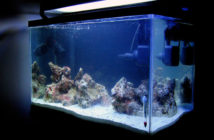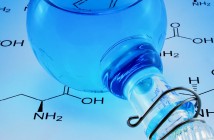Sources of Phosphate
Phosphates come from a wide variety of sources. They can show up in fish and coral foods, fish waste, decaying or uneaten food, aquarium salts, pH and kH buffers, filter media, the water used in the aquarium, and even the sand. And every time you use any of these products, you introduce a little bit more phosphte into the system. If you are having phosphate issues in your aquarium, create a list of everything you add to the tank and research each item. Chances are there are several items on the list that could be responsible and each one has its own unique solution.

Frozen Mysis Shrimp
*Image of Frozen Fish Food Courtesy of Marine Depot
Phosphate Prevention
Phosphates are difficult to prevent and remove from the standard home reef aquarium. The best method of prevention is using pure water when you start the aquarium and do water changes. Some people still use tap water in their reef tanks. Some have even tricked themselves, and others, into believing that water from the “Windmills” and other

AquaFX RODI Water Filter
drinking water self-serve stations is good enough for their aquarium. But the absolutebest method for getting pure water is to purchase a reverse osmosis with deionization water filtration unit, or RO/DI for short. This setup sounds fancy and expensive, but considering the benefits, they are well worth it. Sure, you could buy water from your local fish store to save a little green. But how do know if the water is clean? With

EuroReef RS250 Protein Skimmer
an RO/DI unit of your own, you can monitor and control the quality being produced by changing the filters regularly and using a TDS (Total Dissolved Solids).
Another way to prevent phosphates from getting into your aquarium is by the rinsing/soaking of fish foods, sand, and filtration media prior to their use. Frozen fish food contains phosphate-based binding agents that, with a small investment of time, can be rinsed off. Just place the frozen food into a coffee filter or pantyhose and rinse with RO/DI water. Sand and filtration media can be treated similarly. Since aragonite based sands contain some levels of phosphate, you should soak them in RO/DI water prior to adding it to your aquarium as substrate or using it in a calcium reactor. Soaking the sand will help to leach out some of those phosphates so they don’t make it into your aquarium.

Red Sea Coral Pro Sea Salt
*Image of Aquarium Salt Mix Courtesy of Marine Depot
Other items like aquarium salt mixes and buffers are sort of unavoidable. The best route here is to research each product and find the ones with the lowest amount of phosphates present. Various companies like AquariumWaterTesting.com have done synthetic sea salt studies and others are present as well. But if a product you are using doesn’t have any data regarding their phosphate levels, do a study yourself. Simply make a sample batch using the product and test it with a low range phosphate meter or test kit (the digital meters work the best). If testing isn’t available, do a trial and error in your aquarium. Add the product and notice any changes in algae levels. If algae becomes more pronounced, stop using the product.
Phosphate Removal
Since phosphates will make it into your aquarium no matter what, you have to be prepared for their removal. Large, frequent water changes will help the most, unless of course your salt mix

ZEOvit Additives
is full of phosphates. If that is in fact the case, you might have to take a different approach. A popular method for removing excess phosphates, besides the water change, is the use of phosphate absorbing media like Two Little Fishies Phosban or D-D ROWAphos. These and other phosphate absorbing media utilize ferric oxide hydroxide, which removes both phosphates and silicates. Other than phosphate removing media, there are also phosphate removing chemicals. A big one that comes to mind is ZEOvit. ZEOvit is a dosing procedure that uses ZEOlithic stones and various ZEOvit additives that removes ammonia and phosphates tremendously. It is an expensive dosing regimen, but ZEOvit has spectacular results.

Two Little Fishies Phosban Reactor

PhosBan Media
*Images of TLF PhosBan Reactor and TLF PhosBan Media Courtesy of Marine Depot
Another tool for phosphate removal is the use of Kalkwasser. Kalkwasser, Kalk for short, is a calcium hydroxide based supplement that has been used for calcium supplementation for decades. An additional benefit to raising calcium levels while keeping pH up is its ability to bind phosphates, which essentially make them unusable by algae and other organisms. Kalk has been a favorite calcium delivery method for decades, especially by early German aquarium keepers. Today, Kalk is easily attainable. It can be found as pickling lime, aquarium targeted products, and even soda lime.
The last method of phosphate removal is via the macroalgae populated refugium. The refugium is essentially

Grape Caulerpa
an aquarium located under and plumbed to the display aquarium. Of course, the location is a personal preference, but they all serve the same function…and that is to grow algae. Algae feeds off excess nutrients like nitrates and phosphates. Hence the algae outbreak in the display aquarium when phosphate levels climb. With a refugium, you can control the location of algae growth to some extent. It grows out of site in the refugium and helps keep your display aquarium clean and algae-free. Two popular algae used in the refugium are Caulerpa and Chaetomorpha. They are similar in their requirements, but each has its drawbacks and advantages. For more information on Caulerpa and Chaetomorpha, see Chaetomorpha vs Caulerpa, a previous article we wrote. Simply prune the algae back once it starts to grow out of control and donate the rest to another aquarist who is just starting up or having algae issues in their aquarium.
Permissions and Sources:
Marine Depot
TLF PhosBan Reactor from Marine Depot
TLF PhosBan Media from Marine Depot
Red Sea Coral Pro Salt from Marine Depot





